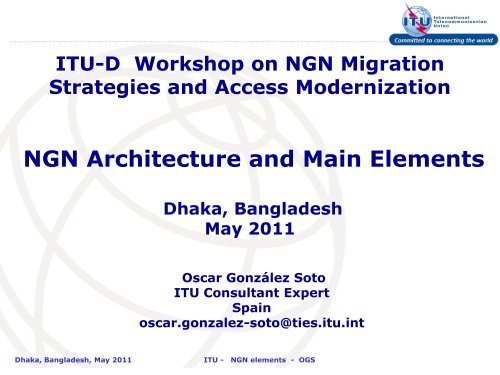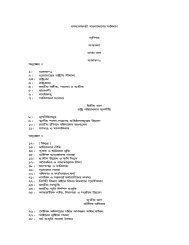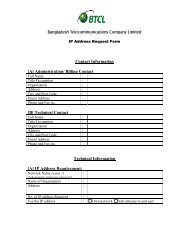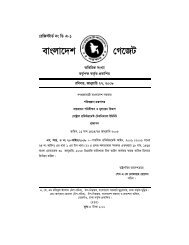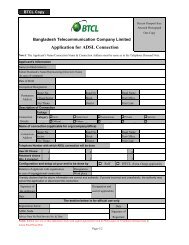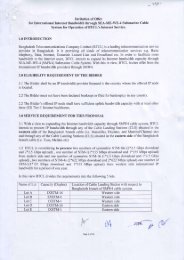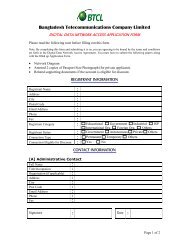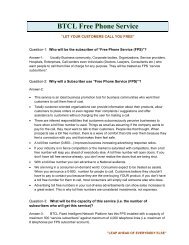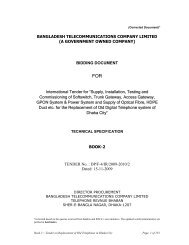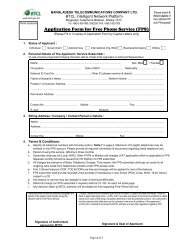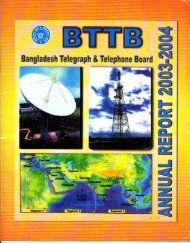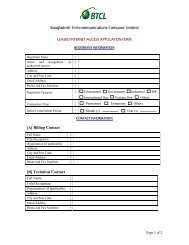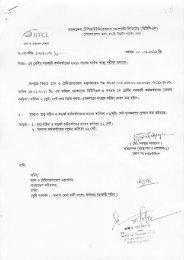1.3 NGN architecture and main elements.ogs.pdf - BTCl
1.3 NGN architecture and main elements.ogs.pdf - BTCl
1.3 NGN architecture and main elements.ogs.pdf - BTCl
Create successful ePaper yourself
Turn your PDF publications into a flip-book with our unique Google optimized e-Paper software.
ITU-D Workshop on <strong>NGN</strong> MigrationStrategies <strong>and</strong> Access Modernization<strong>NGN</strong> Architecture <strong>and</strong> Main ElementsDhaka, BangladeshMay 2011Oscar González SotoITU Consultant ExpertSpainoscar.gonzalez-soto@ties.itu.intDhaka, Bangladesh, May 2011ITU -<strong>NGN</strong> <strong>elements</strong> - OGSInternationalTelecommunicationUnion
<strong>NGN</strong> Concepts <strong>and</strong> Elements• Motivation <strong>and</strong> concept• <strong>NGN</strong> Architecture• Network ElementsDhaka, Bangladesh, May 2011ITU - <strong>NGN</strong> <strong>elements</strong> - OGSInternationalTelecommunicationUnion
Motivation: PremisesStrategic Trendsdata traffic (b<strong>and</strong>width) will become 2 to 5 times higherthan the voice traffic.IP is becoming the universal transport protocol used by allservicesHow PSTN should evolve ?as before, with its dedicated optimised technology (TDM) ?or move to packet IP networks, telephony being a serviceamong others ?Background reasons to evolveservice merge <strong>and</strong> new servicesDSL <strong>and</strong> other broadb<strong>and</strong> access penetrationcost of ownership: unique instead of separated networksDhaka, Bangladesh, May 2011ITU - <strong>NGN</strong> <strong>elements</strong> - OGSInternationalTelecommunicationUnion
Motivation: <strong>NGN</strong> concept•A multi-service network able to support voice, data <strong>and</strong>video•A network with a control plane (signaling, control) separatedfrom the transport/switching plane•A network with open interfaces between transport, control<strong>and</strong> applications•A network using packet mode technology to transport of allkind of information•A network with guaranteed QoS for different traffic types <strong>and</strong>SLAsDhaka, Bangladesh, May 2011ITU - <strong>NGN</strong> <strong>elements</strong> - OGSInternationalTelecommunicationUnion
Motivation: Why• Flexibility for service building <strong>and</strong> offering• Expectation of cost reductions by sharinginfrastructure <strong>and</strong> systems• Simplification of O&M, thus lowering OPEX.• Use of open interfaces leads for:- quick deployment of services <strong>and</strong> applications- new services (third parties)Dhaka, Bangladesh, May 2011ITU - <strong>NGN</strong> <strong>elements</strong> - OGSInternationalTelecommunicationUnion
<strong>NGN</strong> Concepts <strong>and</strong> Elements• Motivation <strong>and</strong> concept• <strong>NGN</strong> Architecture• Network ElementsDhaka, Bangladesh, May 2011ITU - <strong>NGN</strong> <strong>elements</strong> - OGSInternationalTelecommunicationUnion
General functional modelfor <strong>NGN</strong>InternationalTelecommunicationDhaka, Bangladesh, May 2011 ITU - <strong>NGN</strong> <strong>elements</strong> - OGSUnion7
<strong>NGN</strong> Architecture <strong>and</strong>Network ElementsIntelligent NetworkAppl. ServersAccess GatewayN7SignallingSoftswitchMedia GatewayControllerH.248H.248H.248PBXPSTNTrunkingGatewayIP/XXNetworkH.248Access GatewayAccess GatewayInternationalTelecommunicationDhaka, Bangladesh, May 2011 ITU - <strong>NGN</strong> <strong>elements</strong> - OGSUnion8
Network Architecture:Existing networks <strong>and</strong> <strong>architecture</strong>SCPSS7POTSLEX/TEXLEXRSUNMCPCMINISDNTDMDhaka, Bangladesh, May 2011MobNASDataATM/IPMUX/DSLAMHDSL/XDSL• 5 different network types toh<strong>and</strong>le telecom services• TDM for fixed <strong>and</strong> mobilenetworks working in circuitmode with end to endreserved paths• SS7 <strong>and</strong> IN network workingwith message switching mode• Data network working withleased lines <strong>and</strong> packet modewith different <strong>and</strong>conventional IP protocolsITU - <strong>NGN</strong> <strong>elements</strong> - OGSInternationalTelecommunicationUnion
Network ArchitectureExisting networks <strong>and</strong> <strong>architecture</strong>NATIONAL LAYERREGIONAL LAYERLEXLAYERRULAYERcustomersLAYERDhaka, Bangladesh, May 2011TRANSIT NETWORKITU - <strong>NGN</strong> <strong>elements</strong> - OGS• Hierarchical topology with 4to 5 layers, connectivity to theupper next layer <strong>and</strong> withineach layer as a function ofeconomical optimization• Number of nodes as afunction of O/D traffic <strong>and</strong>nodes capacity• Service h<strong>and</strong>ling for media,signaling <strong>and</strong> control at allexchange nodes•Carrier grade quality withwell defined QoS criteria <strong>and</strong>st<strong>and</strong>ardized engineeringrulesInternationalTelecommunicationUnion
Network Architecture:Old <strong>and</strong> New structuresSCPSS7LEX/TEXLEXNMCINMobTDMNASDataATM/IPControlOSSTransport/MediaAccessgatewayAccessgatewayServicesSoftswitch/IMSPacketNetworkIP/MPLS/CACDistributed SwitchingTrunkgatewayAccessgatewayOtherNetworksPCMDSLRSUPOTSISDNMUX/DSLAMWirelessgatewayDLCHDSL/XDSLInternationalTelecommunicationDhaka, Bangladesh, May 2011 ITU - <strong>NGN</strong> <strong>elements</strong> - OGSUnion 11
<strong>NGN</strong> Architecture <strong>and</strong> Elements• Motivation <strong>and</strong> concept• <strong>NGN</strong> Architecture• Network ElementsDhaka, Bangladesh, May 2011ITU - <strong>NGN</strong> <strong>elements</strong> - OGSInternationalTelecommunicationUnion
<strong>NGN</strong> Network ElementsPacket networksInformation is packetized in variable packet sizes with controlheaders to allow appropriate routing <strong>and</strong> deliverytrend is to use IP based networks over various transportpossibilities (ATM, SDH, WDM…)IP networks must offer guarantees of Quality of Service (QoS)regarding the real time characteristics of voiceIPv4Internet Protocol at network level that insert headers for eachpacket in order to allow end to end packet flows: v4 is the firstwidely used version with 20 octet headerIPv6Internet Protocol at network level that insert headers for eachpacket in order to allow end to end packet flows: v6 is the latestversion with 40 octet header <strong>and</strong> adding capabilities for currentrequirements in addressing <strong>and</strong> routingDhaka, Bangladesh, May 2011ITU - <strong>NGN</strong> <strong>elements</strong> - OGSInternationalTelecommunicationUnion
<strong>NGN</strong> Network ElementsDhaka, Bangladesh, May 2011ITU - <strong>NGN</strong> <strong>elements</strong> - OGSInternationalTelecommunicationUnion
<strong>NGN</strong> Network ElementsSoftswitch/MGCreferred to as the Call Agent or Media Gateway Controller(MGC).provides the “service delivery control” within the networkin charge of Call Control <strong>and</strong> h<strong>and</strong>ling of Media Gatewayscontrol (Access <strong>and</strong>/or Trunking) via H.248 protocolperforms signalling gateway functionality or uses a signallinggateway for interworking with PSTN N7 signalling networkprovides connection to Intelligent Network /applicationsservers to offer the same services as those available to TDMsubscribersApplication Server (AS):A unit that supports service execution, e.g. to control CallServers <strong>and</strong> <strong>NGN</strong> special resources (e.g. media server, messageserver).Dhaka, Bangladesh, May 2011ITU - <strong>NGN</strong> <strong>elements</strong> - OGSInternationalTelecommunicationUnionslide 16
<strong>NGN</strong> Network ElementsH.248 ProtocolKnown also as MEGACO: st<strong>and</strong>ard protocol, defined byITU-T, for signalling <strong>and</strong> session management neededduring a communication between a media gateway, <strong>and</strong> themedia gateway controller managing itH.248/MEGACO allows to set up, keep, <strong>and</strong> terminate callsbetween multiple endpoints as between telephonesubscribers using the TDMSIPSession Initiation Protocol in order to h<strong>and</strong>lecommunication signalling <strong>and</strong> negotiation like callestablishment, <strong>main</strong>tenance <strong>and</strong> termination from packetmode terminals. Has a distributed peer to peerimplementationDhaka, Bangladesh, May 2011ITU - <strong>NGN</strong> <strong>elements</strong> - OGSInternationalTelecommunicationUnionslide 17
<strong>NGN</strong> Network ElementsSignaling Gateway (SG):A unit that provides signaling conversion between the<strong>NGN</strong> <strong>and</strong> the other networks (e.g. STP in SS7).ENUMElectronic NUMbering: Protocol that allows to establish acorrespondence between the traditional telephonenumbering (E.164 ) <strong>and</strong> the network addresses related tothe packet mode networks ( RFC 2916 "E.164 number <strong>and</strong>DNS" IETF).Dhaka, Bangladesh, May 2011ITU - <strong>NGN</strong> <strong>elements</strong> - OGSInternationalTelecommunicationUnionslide 18
<strong>NGN</strong> Network ElementsMPLSMultiprotocol Label Switch or protocol that assigns labels toinformation packets in order to allow the node routers to treat <strong>and</strong>route flows in the network paths according to established priorityfor each category. Establishes a tunnel for an end to endforwarding. A label is a short, fixed length, locally significantidentifier which is used to identify a "Forwarding EquivalenceClass" (FEC ) to which that packet is assigned."LSPLabel-switched paths: An LSP is a specific traffic path that usingconvenient protocols will establish a path through an MPLSnetwork <strong>and</strong> will reserve necessary resources to meet pre-definedservice requirements for the data path.Dhaka, Bangladesh, May 2011ITU - <strong>NGN</strong> <strong>elements</strong> - OGSInternationalTelecommunicationUnionslide 19
<strong>NGN</strong> Network ElementsOSPFOpen Shortest Path First: A routing protocol thatdetermines the best path for routing IP traffic over a TCP/IPnetwork based on distance between nodes <strong>and</strong> severalquality parameters. OSPF is an interior gateway protocol(IGP), which is designed to work within an autonomoussystemBGPBorder Gateway Protocol: performs inter-do<strong>main</strong> routing inTCP/IP networks, h<strong>and</strong>ling routing between multipleautonomous do<strong>main</strong>s. Routers use BGP to <strong>main</strong>tain aconsistent view of the internetwork topologyDhaka, Bangladesh, May 2011ITU - <strong>NGN</strong> <strong>elements</strong> - OGSInternationalTelecommunicationUnionslide 20
<strong>NGN</strong> Network ElementsTraffic Engineering ModuleTraffic Engineering refers to the process of selecting the paths (LSPs) inorder to balance the traffic load on the various links, routers, <strong>and</strong> switchesin the network. A major goal of Traffic Engineering is to facilitate efficient<strong>and</strong> reliable network operations with guarantee of QoS whilesimultaneously optimizing network resource utilization <strong>and</strong> trafficperformanceCACCall Acceptance Control function in order to accept/reject traffic in thenetwork that allows guarantee of QoS for services with a given ServiceLevel AgreementDhaka, Bangladesh, May 2011ITU - <strong>NGN</strong> <strong>elements</strong> - OGSInternationalTelecommunicationUnion21
<strong>NGN</strong> Network ElementsIMSIP Multimedia Subsystem: architectural framework for deliveringIP multimedia services. It was originally designed by the wirelessst<strong>and</strong>ards body 3 rd Generation Partnership Project (3GPP) formobile services <strong>and</strong> later extended to all types of networks.It has a multilayer structure with a transport stratum <strong>and</strong> a servicestratum containing all transport, control <strong>and</strong> application functionsas well as defined interfaces to external 3 rd party applications,OSS, BSS, NM <strong>and</strong> other networks.Dhaka, Bangladesh, May 2011ITU - <strong>NGN</strong> <strong>elements</strong> - OGSInternationalTelecommunicationUnion22
<strong>NGN</strong> Network ElementsDiameterThe Diameter base protocol defines the minimum requirements forAuthentication, Authorization <strong>and</strong> Accounting (AAA) in an IMS network<strong>and</strong> is the successor of the Radius protocol by incorporating advancedfunctionalities.IPsecIPsec is an end-to-end security scheme operating in the Internetlayer within a protocol suite including among others the ESP(Encapsulating Security Payload) . It can be used in protecting dataflows between a pair of hosts (host-to-host), between a pair ofsecurity gateways (network-to-network), or between a securitygateway <strong>and</strong> a host (network-to-host). Used procedure is by meansof authentication <strong>and</strong> encryption of each IP packet of acommunication session.Dhaka, Bangladesh, May 2011ITU - <strong>NGN</strong> <strong>elements</strong> - OGSInternationalTelecommunicationUnion23
<strong>NGN</strong> Network ElementsIMS ArchitectureInternationalTelecommunicationDhaka, Bangladesh, May 2011 ITU - <strong>NGN</strong> <strong>elements</strong> - OGSUnion 24
<strong>NGN</strong> Network ElementsIMS Functional Structure <strong>and</strong>InterfacesOther IP Multimedia NetworksASPSTNMmISCShMbMbMGW BGCFMbMRFPPSTNMkMjMnMpMGCFMRCFBGCFMgMrCSCFMwMiCSCFP - CSCFMwHSS(AAA+DB)CxDxDhSLFMbGqGmIP Connectivity Access NetworkUEInternationalTelecommunicationDhaka, Bangladesh, May 2011 ITU - <strong>NGN</strong> <strong>elements</strong> - OGSUnion 25
<strong>NGN</strong> Network ElementsIMS ArchitectureIMS <strong>main</strong> functional <strong>elements</strong>:•Application Server (AS)• Voice Application Servers (VAS)• Instant Messaging (IM)•Home Subscriber Server (HSS)•Call Session Control Function (CSCF)•Breakout Gateway Control Function (BGCF)•Media Gateway Function (MGW)•Media Gateway Control Function (MGCF)•Multimedia Resource Function Controller (MRFC)•Multimedia Resource Function Processor (MRFP)InternationalTelecommunicationDhaka, Bangladesh, May 2011 ITU - <strong>NGN</strong> <strong>elements</strong> - OGSUnion 26
<strong>NGN</strong> Network ElementsIMS ArchitectureApplication Server (AS)• Contains Call Related Application Logic• Facilitates a Service Creation Environment• Queried by S-CSCF in Real Time to Execute Logic• Generally Specialized for Each Service• May Provide Gateway to Legacy Applications (e.g. AIN)InternationalTelecommunicationDhaka, Bangladesh, May 2011 ITU - <strong>NGN</strong> <strong>elements</strong> - OGSUnion 27
<strong>NGN</strong> Network ElementsFlow control at core <strong>NGN</strong>InternationalTelecommunicationDhaka, Bangladesh, May 2011 ITU - <strong>NGN</strong> <strong>elements</strong> - OGSUnion 28
<strong>NGN</strong> Network ElementsFlow control at core <strong>NGN</strong>InternationalTelecommunicationDhaka, Bangladesh, May 2011 ITU - <strong>NGN</strong> <strong>elements</strong> - OGSUnion 29
<strong>NGN</strong> Network ElementsFlow control at core <strong>NGN</strong>InternationalTelecommunicationDhaka, Bangladesh, May 2011 ITU - <strong>NGN</strong> <strong>elements</strong> - OGSUnion 30
<strong>NGN</strong> Concepts <strong>and</strong> ElementsStatus today• Available today for application in many networksfort most <strong>elements</strong>• Recently defined functionalities <strong>and</strong> interoperationst<strong>and</strong>ardized <strong>and</strong> being deployed with adjustmentsneeded• Careful planning needed for operators with existinginfrastructure <strong>and</strong> operation (migration, profitability,QoS <strong>and</strong> survivability)Dhaka, Bangladesh, May 2011ITU - <strong>NGN</strong> <strong>elements</strong> - OGSInternationalTelecommunicationUnionslide 31
<strong>NGN</strong> Concepts <strong>and</strong> ElementsSummary of <strong>main</strong> factors• Main advantage of <strong>NGN</strong> based on IP is theflexibility for many services• <strong>NGN</strong> for all services with required quality is notjust IP or internet• Most functionalities <strong>and</strong> performance for publicnetworks in operation today. Some multi-do<strong>main</strong>interoperation requiring agreementsDhaka, Bangladesh, May 2011ITU - <strong>NGN</strong> <strong>elements</strong> - OGSInternationalTelecommunicationUnion


